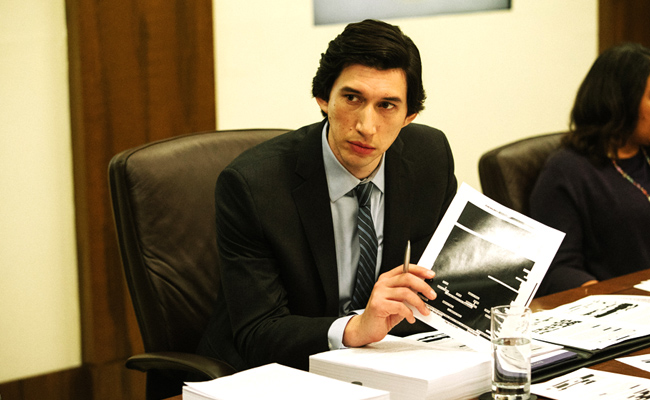
(Editor’s note: This review originally ran in January, but we’re republishing it since the movie is finally opening in theaters on November 15.)
The Report is a political thriller about uncovering the CIA’s torture program that plays out like a national security version of Spotlight or The Insider, a taut barnburner that’s explosive without explosions. It’s a movie that largely takes place in the world of government bureaucracy that never forgets the human costs of their policy decisions.
Written and directed by Steven Soderbergh collaborator Scott Z. Burns (Soderbergh also produced), The Report opens with a title card that says “The Torture Report” with the word “torture” quickly redacted. “The Torture Report” would’ve been a cooler title (hey, if BlackKklansman can do creative typography), but in any case it’s the last time the film plays coy.
Adam Driver plays Daniel J. Jones, a Senate staffer who spent five years trying to expose the CIA’s program of torture, er, “enhanced interrogation techniques.” Much of it takes place in courtrooms and boardrooms and offices, but it also doesn’t shirk from the blood, shit, and puke of what “enhanced interrogation” actually looks like. So much of the public debate on the subject involves utilitarian discussions of whether torture produces actionable intelligence, or legal/semantic ones about whether torture is allowed under US law or the Geneva convention. It’s easy to get lost in the drone of ghoulish rationalizations and forget that what we’re talking about is shoving tubes up peoples’ assholes and locking them in coffins until they go crazy as official policy. The Report doesn’t dwell on visual depictions of torture to the point that feels excessive or indulgent, or like it’s fishing for awards, but it offers just enough viscerality to be crystal clear on what this story is really about.
In fact, The Report is not without humor. The two charlatans who sell the torture program to the CIA in the first place, retired Air Force psychologists played by Douglas Hodge and T. Ryder Smith, are like a sadistic Marx brothers duo, convincing the CIA that they have the “special sauce” for interrogations through a series of surreally cruel but anodyne power points — execution orders written in comic sans. They deflect questions about their ridiculous methods with deadpan one-liners, playing off an increasingly exasperated CIA agent played by Maura Tierney.
“I thought your methods were supposed to find the truth,” she demands.
“Yes…” Hodge’s Jim Mitchell carefully explains. “And we found out the truth is that he’s lying.”
I’d happily watch a dark comedy spinoff just about these two, a Catch 22 for the age of corporatized imperial brutality. The Report isn’t that movie, much more concerned as it is with being the Spotlight of torture. And it’s better than Spotlight. The story is bigger, the stakes clearer, and Adam Driver’s labial skillet face is the perfect canvas for the revelation, reserve, and tempered furiousity the role of whistleblower requires. Every Girls hater should be forced to at least acknowledge that the show gave us Adam Driver and show the proper deference. What a gift.
It’s interesting to see this pointed a critique of the national security apparatus in a mainstream Hollywood film, when Hollywood has so long been at worst complicit and at best overly credulous to CIA-backed narratives. The Report is not only a corrective just by its mere existence, it also calls out Zero Dark Thirty by name, for going along with the CIA-pushed narrative that enhanced interrogations helped obtain the information that led to the Bin Laden assassination. It was a movie with five Oscar nominations that was, at best, neutral towards torture and extra-judicial assassination. Driver’s Jones also makes fun of 24, a schlock show that rests on the notion that beating people up will force them to give up the nuclear codes.
The Report is equally unsparing of Obama administration. It depicts the White House protecting, and even promoting, torturers in the CIA — out of loyalty towards the CIA for killing Bin Laden and helping Obama win the election. It portrays Obama staffers stalling the report and dragging their feet on prosecuting anyone, hanging the CIA’s dissenters out to dry in the process, in a naive interpretation of Obama’s campaign promise to be “post-partisan.” The Report presents this matter of factly, but it’s downright groundbreaking compared to the quasi-Sovietesque personality cult Obama usually inspires among filmmakers (see Barry, Southside With You). It says a lot that The Report cast Buffalo Bill (Ted Levine, a wonderful character actor whose face and voice have only gotten more terrifying with age) as Obama CIA appointee John Brennan.
By contrast, the film does go a bit soft focus on Dianne Feinstein and John McCain. It depicts Feinstein — played by Annette Bening — as hawkish and politically opportunistic at times, but as someone who will hedge and whinge and delay action but ultimately do the right thing (whether she’s too late in doing the right thing The Report leaves slightly up for interpretation). John McCain is offscreen and unmentioned for most of the movie until he gets his Mr. Smith Goes To Washington moment via stock footage at the end, giving a big, heartfelt speech about the immorality of torture in front of the Senate. It might be a little hard to stomach, an otherwise name-naming movie posthumously cosigning McCain’s fake maverick act, but it is a good speech that works in the narrow confines of the movie.
The Report has just enough humor and absurdity and Adam Driver to cut through its justified righteous indignation. It doesn’t sacrifice importance for entertainment, or vice versa. It’s a movie about the power of naming names that isn’t afraid to name names itself, a movie about admitting mistakes in order to change that represents a symbolic act of Hollywood admitting theirs.
Vince Mancini is on Twitter. You can find his archive of reviews here.






